

Treasure items from Atlantis
(Click on icons to learn more)
The Atlantean Age once used certain remarkable technological items that would be wonderful treasure artifacts in any museum.
1/ It is important to realize that the greatest treasure within this research project lies not in some physical object, but rather in the creative mental understanding of when, where and how humans became humankind.
2/ However, for material sake, the existence of, say, five major antediluvian treasure items from the Atlantean Age, would be priceless artifacts that would be great showpieces in any museum.
3/ Perhaps the first and most elaborate item mention by Plato would be a "golden statue of the god (Oceanus) standing in a chariot drawn by six winged horses" which stood within a temple next to the "altar of Atlantis" at the center of the main island.
4/ Now this "statue" is probably not the conventional concept of what represents a frozen piece of art work, but rather was only a word chosen by Plato that describes a large and very unusual chariot-like vehicle.
5/ We have all been shown, at some time or another, pictures of some Greek god driving his two-wheel chariot - but not many of those pictures showed that "winged horses" were used to fly the chariot.
(Auriga, the mythical flying charioteer and autumn constellation, was pictured, like Helios, as driving or flying his "car" across the sky)
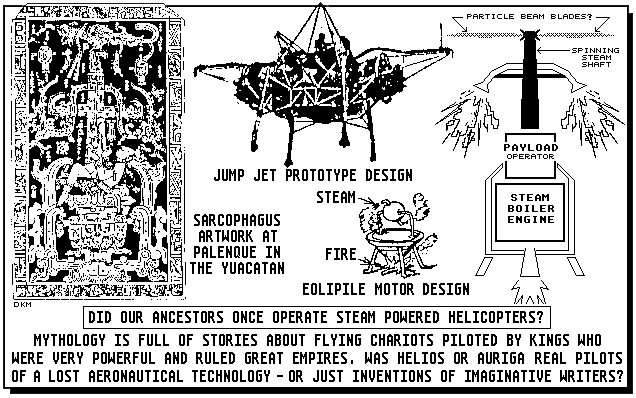
This view suggest the novel idea that there may have once existed in ancient times a lost technology which could have allowed humans to fly by using steam motor power and other "controlled forces" from gyroscopic devices. Also viewed is the graphical similarity between the famous Mayan "aircraft" artwork at Palenque in Mexico and the first prototype design of a vertical powered aircraft in recent times.
7/ As to the actual design and function of this ancient steam powered helicopter, let us say for now that this highly decorated aircraft used several pyroelectric charged "blades" which were attached to the top of the main rotary shaft and was steered by controlling several large gyroscopic stabilizers.
(There exists in the Mayan settlement of Palenque - some two-hundred miles north of Lake Izabal, engraved upon a sarcophagus lid a somewhat famous illustration in which a "pilot" is sitting on a "throne" under which seems to be some kind of chamber that may be a "boiler" out of which rises a shaft to the top of the "craft")
[When the Biblical prophet Ezekiel was given a ride in "god's car", he described the craft as having "wheels within wheels", which could have been the gyroscopic rings of a several stabilizers that gave a controlling effect to the vehicle]
8/ Speaking of flying chariots, there is a section of Plato's dialogue, wherein TIMAEUS 22.C, he describes an interesting legend known as the "fall of Phaethon" by which Phaethon, the son of "the Sun-god", "having yoked the steeds in his father's chariot, because he was not able to drive them in the path of his father, burned up all that was upon the earth, and was himself destroyed by a thunderbolt".
9/ Although this mythical legend was perhaps a personified explanation of an ancient cometary conflagration, wonder has it also that a descriptive story, handed down through the ages, about how a boy once crashed his dad's "flying-car" -- given the new perspective that such an exotic flying machine actually existed, might have really happened!
10/ Let me say that this ancient flying vehicle was not an interplanetary spaceship, but was rather only a highly decorated lifting platform that was powered by a steam motor -- similar to an eolipile (or aeolipile) motor.
11/ As to how the pyroelectric charged "blades" worked on such a vehicle, that will be covered in our next treasure item.
12/ Any attempt to recover this item -- or any of the following items from the muddy bottom of Lake Izabal, would probably be very difficult, if not almost impossible, because the main earthquake event that destroyed the area was very large and nearly a thousand years of untold erosional events has erased perhaps all evidence of their existence.
13/ The second most impressive item that Plato suggest would be the "altar of Atlantis" -- which was located near the temple "hanger" that our "aircraft" was kept.
14/ Now this altar arrangement was probably similar to the current altar setup within a Christian church, but with several extraordinary uses for such items as the "font" (baptism or lamp oil receptacle) and the "monstrance" (a sometimes very large device that looks like a big crystal microphone which, according to the dictionary, "exposes the consecrated Host to the multitude").
(Much of the description of this treasure item is covered in Chapter five of this Volume)
15/ Although Plato does not describe this altar in great detail, he does explain that the seaport itself was created by a cutting tool which is very similar to how this altar works.
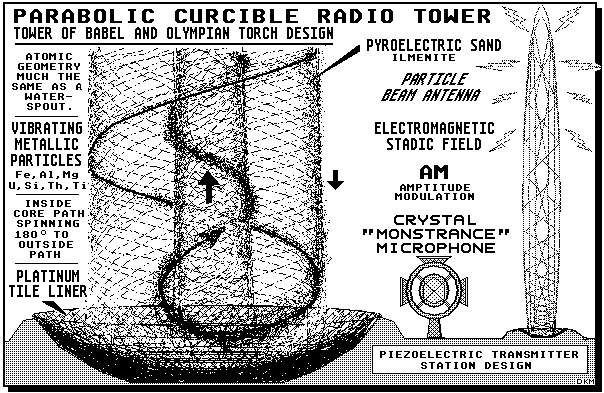
This view represents a theoretical concept in which some of our ancient ancestors once used the
fantastic knowledge of "particle beam" technology. This lost ability to develop "photolytic torches"
eventually evolved into a very powerful transmitter radio station.
The electromagnetic static field used piezoelectric power to send wireless messages over great distances.
Perhaps the "fire" that Prometheus took from "the heavens" was this lost technology.
Perhaps the "Tower of Babel" that Nimrod created used this lost technology.
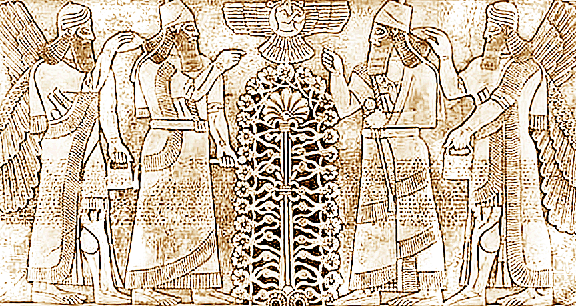
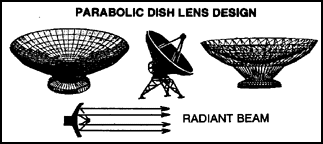
Parabolic Dish Lens Design.
The use of highly polished concave mirrors of magnetite, ilmenite and hematite have been found at the Olmec site of La Venta. Refered to as "smoking mirrors", they were worn as pendants, buckles and perhaps as fore-head light-reflectors by shamans -- much like the doctor's "head-lamp". Modern day solar lighters use the same refraction principle. Satellite
dishes are also based on the same radiant angle phenomenon.
According to traditional descriptions regarding the Holy Grail, the "cup" or "vessel" that Christ used at the Last Supper was portrayed as a silver "dish" in which he performed a sacramental act. Why it became the object of great quest was perhaps its ability to "Enlighten the Masses".
18/ The third treasure item from Atlantis mentioned by Plato, but no less inspiring than the first two, would be the "Obelisk of Laws" -- on which were engraved certain commandments, that stood at the center acropolis.
19/ What really makes this artifact so valuable is the substance it was carved from.
20/ In 114.E of the CRITIAS dialogue Plato writes: It (the land of Atlas) yielded all products of the miner's industry, solid and fusible alike, including one which is now only a name but was then something more, orichalch, which was excavated in various parts of the island, and had then a higher value than any metal except gold.
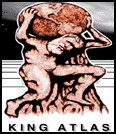
ORICHALCH is Alkaline Feldspar Granite.
Plato states that the innermost stone wall of the Atlantean seaport was made of "orichalch". The essential components of this intrusive igneous rock contains potassic feldspar quarts with biotite, pyrite, zircon, monazite, magnetite, tourmaline, and ilmenite. The appearance is rosy to dark red with bluish specks and can be found in marginal intrusions leading to magmatic depths. These granite rocks are highly prized as POLISHED BUILDING SLABS and are also used extensively in the extraction of RARE EARTH BEARING MINERALS.
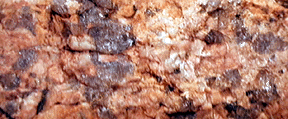
22/ This special type of rose granite is an intrusive igneous variety that contains many rare-earth radioactive elements.
(The largest sarcophagus of Ramses Two was recently discovered near Cairo and was carved from this alkaline feldspar granite)
23/ It is used today almost exclusively for the extraction of rare earth-bearing minerals and also as a building material when polished into decorative slabs.
(Plato also mentions that portions of the main temple were also built out of orichalch)
[Large amounts of this unique rock can be found on the north coast of Brittany]
24/ Perhaps because the chemical makeup of this special stone includes several substances that when "fired up" causes a nuclear reaction -- and that reaction, when focused by the shape of a parabolic lens of platinum, is what made this treasure valuable!
25/ An interesting perspective at this time should be noted in that Plato describes the substantive makeup of three of the seaport walls which surrounds the central palace.
26/ He says that the first wall of the central palace area was made from "orichalch - which gleamed like fire", the second wall of the main island was made by "pouring molten tin", and the third outermost wall was "coated with ceruse".
27/ Now "ceruse" happens to be a substance made from cerusite (lead carbonate) that could have caused saturnism -- or lead poisoning, among the inhabitants of the Atlantean seaport.
28/ And if the residents of this antediluvian seaport where ignorant of how lead can creep into the body over time and poison the victim, imagine the negative behavior that may have gradually appeared among many ancient rulers of both the New and Old Worlds!
29/ Was the titanic god of the Roman realm, known as Kronus or Saturn, suffering from saturnism whereby his Olympian son of the Greek realm, known as Zeus, revolted against him because of his "bad temperament"?
30/ In other words, did Zeus and Kronus fight each other because one or both acted in bad temperament as a result of lead poisoning?
31/ If so, then this great antediluvian civil war between the Atlantean and Hellenic Empires that Plato wrote about could have been caused, in essence, by a slow chemical poisoning among important rulers on both sides who ignorantly abused their military powers.
(Remember, many believe that lead poisoning caused the Roman Empire to fall)
[The chemical symbol "Pb" originated from the latin word for PlumBing - as in lead pipes once used for providing drinking water]
32/ The fourth item from Atlantis would be a type of vessel design that Plato describes when he gives the layout of the harbor and the wide subterranean passageways of the seaport.

The Atlantean Trimaran.
The art of building multihull "rafts" with Lateen sails by our ancestors was lost when the Atlantean maritime kingdom was engulfed in the Biblical Flood. The Trimaran design can be more seaworthy than many mono-hull designs if the proper demensions are used.
34/ Modern day trimarans come in all sorts of configurations, but perhaps the trans-Atlantic traders of Atlantis used a special configuration -- one that uses a very long main hull with smaller stabilizing hulls placed slightly forward from center -- say at the 5/8 mark.
35/ This treasure is really not an item to be uncovered -- although one may be discovered somewhere someday, but rather this a valuable design that could sail the world's oceans again soon.
36/ The fifth and last treasure covered in this chapter is also a lost design -- a design not mentioned by Plato, but in every aspect, belongs with the word "Atlantis".
37/ The key word that describes the word "treasure" is the word "valuable" -- and ever since recorded history one of the most valuable items has been a "thing" known as "the Golden Fleece".
38/ What was "the Golden Fleece" and how does it relate to the subject of Atlantis you ask?
39/ Let's first explore just what was "the Golden Fleece" by reviewing the standard mythical description of the object.
40/ According to a very early heroic poem, "the Golden Fleece" was the flying "wondrous ram" that carried Hermes near the seaside cliffs whereon he rescued two children from being sacrificed.
41/ That's it - forget about all those hollywood movies that showed how Jason and his Argonauts went looking for some sparkling sheepskin.

This view represents a possible answer to the most enduring treasure mystery of what really was the Golden Fleece. For centuries writers have assumed that this item was some kind of "sparkling sheepskin" - capable of "instant healing", however, new research suggest that it represents the aerodynamic design of a ram-like kite. How this unique Atlantean kite design could psychologically heal the sick is explained.
43/ Although much of this treasure item was covered in Volume Two, Chapter Five, let us further explore this ancient hang-glider design and see how modern technology could improve upon it.
44/ First, the shape of the wing foil is essentially the same as the shape of the Lateen sail-rig - but doubled to create the standard looking delta hang-glider design.
(The particular ram-like design pictured with this Chapter does not generate any wing-tip vortices while gliding through a suspended particle cloud in water because the wing is a thin foil -- therefore there is no displacement volume within the wing to create the phenomenon of wing-tip drag like what is found in conventional aircraft wings)
45/ Second, the shape of the payload, if operating from water should be able to rotate easily for takeoff and be able the land safely in rough water.
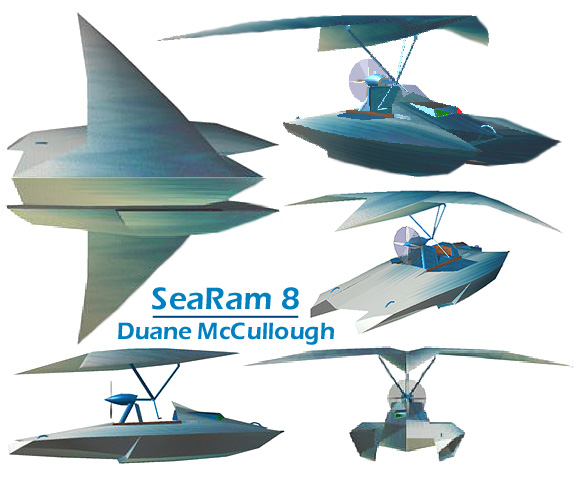
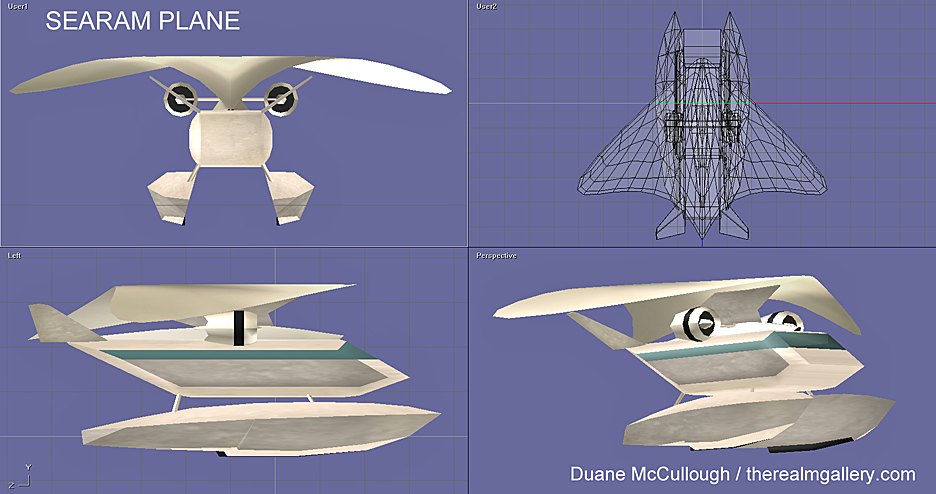
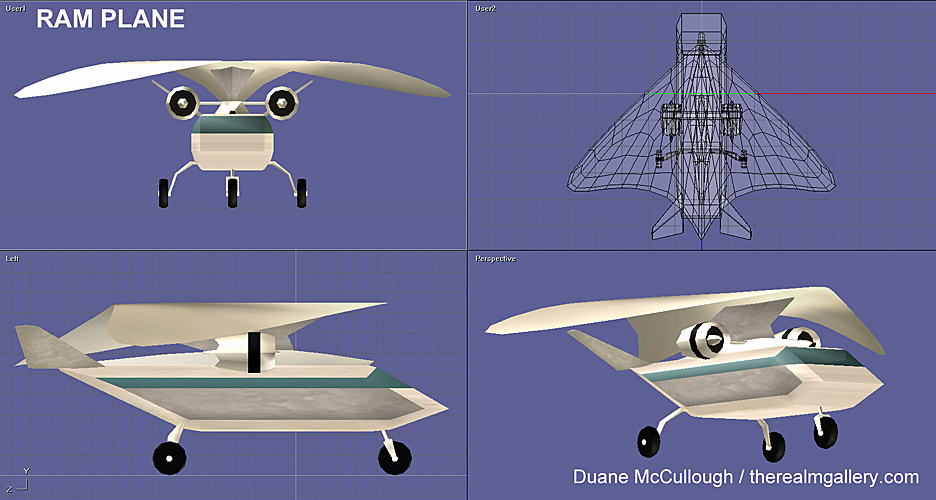
The SeaRam Plane Project.
The SeaRam seaplane project series is based on the idea that a new type of simple seaplane design could be available for commerce soon. Made from lightweight corrosion-resistant composite materials and powered by electric jet thrusters, the SeaRam Kite Boat design should be capable of flying great distances over water. Large versions should be able to carry passengers and/or cargo from seaports around the world much like the great seaplanes did some fifty years ago.
47/ Imagine cruising the islands someday by flying your own ram-like "live-a-board" seaplane!
48/ Imagine catching the ram-like "sea-shuttle bus" over to the islands or maybe up the coast to the nearest city!
49/ Imagine taking a voyage across some ocean in the near future and looking out the panoramic window of some large ram-like flying ferryboat!
50/ Atlantis also had this ram-like seaplane design -- but probably not as big and elaborate as what will be built soon!